Mário A. T. Figueiredo
Sparse Activations as Conformal Predictors
Feb 23, 2025Abstract:Conformal prediction is a distribution-free framework for uncertainty quantification that replaces point predictions with sets, offering marginal coverage guarantees (i.e., ensuring that the prediction sets contain the true label with a specified probability, in expectation). In this paper, we uncover a novel connection between conformal prediction and sparse softmax-like transformations, such as sparsemax and $\gamma$-entmax (with $\gamma > 1$), which may assign nonzero probability only to a subset of labels. We introduce new non-conformity scores for classification that make the calibration process correspond to the widely used temperature scaling method. At test time, applying these sparse transformations with the calibrated temperature leads to a support set (i.e., the set of labels with nonzero probability) that automatically inherits the coverage guarantees of conformal prediction. Through experiments on computer vision and text classification benchmarks, we demonstrate that the proposed method achieves competitive results in terms of coverage, efficiency, and adaptiveness compared to standard non-conformity scores based on softmax.
Conformal Prediction for Natural Language Processing: A Survey
May 03, 2024Abstract:The rapid proliferation of large language models and natural language processing (NLP) applications creates a crucial need for uncertainty quantification to mitigate risks such as hallucinations and to enhance decision-making reliability in critical applications. Conformal prediction is emerging as a theoretically sound and practically useful framework, combining flexibility with strong statistical guarantees. Its model-agnostic and distribution-free nature makes it particularly promising to address the current shortcomings of NLP systems that stem from the absence of uncertainty quantification. This paper provides a comprehensive survey of conformal prediction techniques, their guarantees, and existing applications in NLP, pointing to directions for future research and open challenges.
Cost-Sensitive Learning to Defer to Multiple Experts with Workload Constraints
Mar 21, 2024
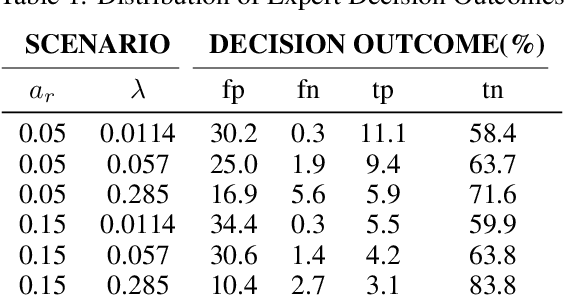
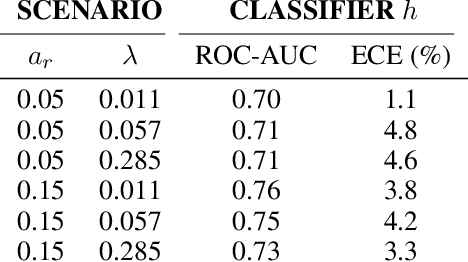

Abstract:Learning to defer (L2D) aims to improve human-AI collaboration systems by learning how to defer decisions to humans when they are more likely to be correct than an ML classifier. Existing research in L2D overlooks key aspects of real-world systems that impede its practical adoption, namely: i) neglecting cost-sensitive scenarios, where type 1 and type 2 errors have different costs; ii) requiring concurrent human predictions for every instance of the training dataset and iii) not dealing with human work capacity constraints. To address these issues, we propose the deferral under cost and capacity constraints framework (DeCCaF). DeCCaF is a novel L2D approach, employing supervised learning to model the probability of human error under less restrictive data requirements (only one expert prediction per instance) and using constraint programming to globally minimize the error cost subject to workload limitations. We test DeCCaF in a series of cost-sensitive fraud detection scenarios with different teams of 9 synthetic fraud analysts, with individual work capacity constraints. The results demonstrate that our approach performs significantly better than the baselines in a wide array of scenarios, achieving an average 8.4% reduction in the misclassification cost.
DiConStruct: Causal Concept-based Explanations through Black-Box Distillation
Jan 26, 2024
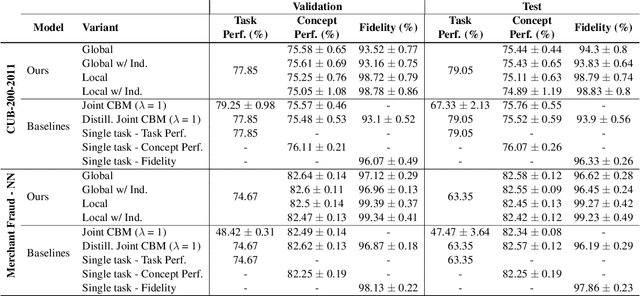
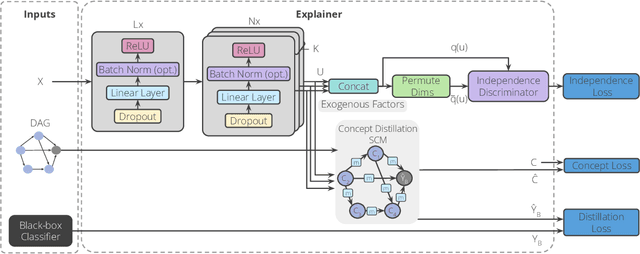
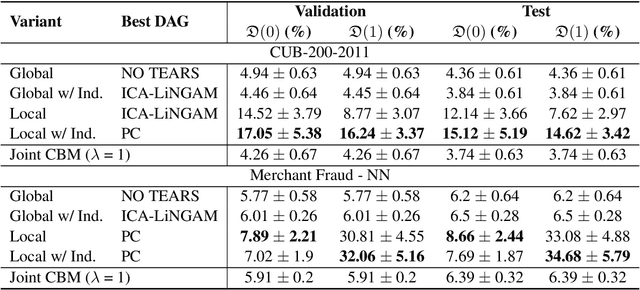
Abstract:Model interpretability plays a central role in human-AI decision-making systems. Ideally, explanations should be expressed using human-interpretable semantic concepts. Moreover, the causal relations between these concepts should be captured by the explainer to allow for reasoning about the explanations. Lastly, explanation methods should be efficient and not compromise the performance of the predictive task. Despite the rapid advances in AI explainability in recent years, as far as we know to date, no method fulfills these three properties. Indeed, mainstream methods for local concept explainability do not produce causal explanations and incur a trade-off between explainability and prediction performance. We present DiConStruct, an explanation method that is both concept-based and causal, with the goal of creating more interpretable local explanations in the form of structural causal models and concept attributions. Our explainer works as a distillation model to any black-box machine learning model by approximating its predictions while producing the respective explanations. Because of this, DiConStruct generates explanations efficiently while not impacting the black-box prediction task. We validate our method on an image dataset and a tabular dataset, showing that DiConStruct approximates the black-box models with higher fidelity than other concept explainability baselines, while providing explanations that include the causal relations between the concepts.
FiFAR: A Fraud Detection Dataset for Learning to Defer
Dec 20, 2023Abstract:Public dataset limitations have significantly hindered the development and benchmarking of learning to defer (L2D) algorithms, which aim to optimally combine human and AI capabilities in hybrid decision-making systems. In such systems, human availability and domain-specific concerns introduce difficulties, while obtaining human predictions for training and evaluation is costly. Financial fraud detection is a high-stakes setting where algorithms and human experts often work in tandem; however, there are no publicly available datasets for L2D concerning this important application of human-AI teaming. To fill this gap in L2D research, we introduce the Financial Fraud Alert Review Dataset (FiFAR), a synthetic bank account fraud detection dataset, containing the predictions of a team of 50 highly complex and varied synthetic fraud analysts, with varied bias and feature dependence. We also provide a realistic definition of human work capacity constraints, an aspect of L2D systems that is often overlooked, allowing for extensive testing of assignment systems under real-world conditions. We use our dataset to develop a capacity-aware L2D method and rejection learning approach under realistic data availability conditions, and benchmark these baselines under an array of 300 distinct testing scenarios. We believe that this dataset will serve as a pivotal instrument in facilitating a systematic, rigorous, reproducible, and transparent evaluation and comparison of L2D methods, thereby fostering the development of more synergistic human-AI collaboration in decision-making systems. The public dataset and detailed synthetic expert information are available at: https://github.com/feedzai/fifar-dataset
Fairness-Aware Data Valuation for Supervised Learning
Mar 29, 2023


Abstract:Data valuation is a ML field that studies the value of training instances towards a given predictive task. Although data bias is one of the main sources of downstream model unfairness, previous work in data valuation does not consider how training instances may influence both performance and fairness of ML models. Thus, we propose Fairness-Aware Data vauatiOn (FADO), a data valuation framework that can be used to incorporate fairness concerns into a series of ML-related tasks (e.g., data pre-processing, exploratory data analysis, active learning). We propose an entropy-based data valuation metric suited to address our two-pronged goal of maximizing both performance and fairness, which is more computationally efficient than existing metrics. We then show how FADO can be applied as the basis for unfairness mitigation pre-processing techniques. Our methods achieve promising results -- up to a 40 p.p. improvement in fairness at a less than 1 p.p. loss in performance compared to a baseline -- and promote fairness in a data-centric way, where a deeper understanding of data quality takes center stage.
Distinguishing Cause from Effect on Categorical Data: The Uniform Channel Model
Mar 14, 2023Abstract:Distinguishing cause from effect using observations of a pair of random variables is a core problem in causal discovery. Most approaches proposed for this task, namely additive noise models (ANM), are only adequate for quantitative data. We propose a criterion to address the cause-effect problem with categorical variables (living in sets with no meaningful order), inspired by seeing a conditional probability mass function (pmf) as a discrete memoryless channel. We select as the most likely causal direction the one in which the conditional pmf is closer to a uniform channel (UC). The rationale is that, in a UC, as in an ANM, the conditional entropy (of the effect given the cause) is independent of the cause distribution, in agreement with the principle of independence of cause and mechanism. Our approach, which we call the uniform channel model (UCM), thus extends the ANM rationale to categorical variables. To assess how close a conditional pmf (estimated from data) is to a UC, we use statistical testing, supported by a closed-form estimate of a UC channel. On the theoretical front, we prove identifiability of the UCM and show its equivalence with a structural causal model with a low-cardinality exogenous variable. Finally, the proposed method compares favorably with recent state-of-the-art alternatives in experiments on synthetic, benchmark, and real data.
ProBoost: a Boosting Method for Probabilistic Classifiers
Sep 04, 2022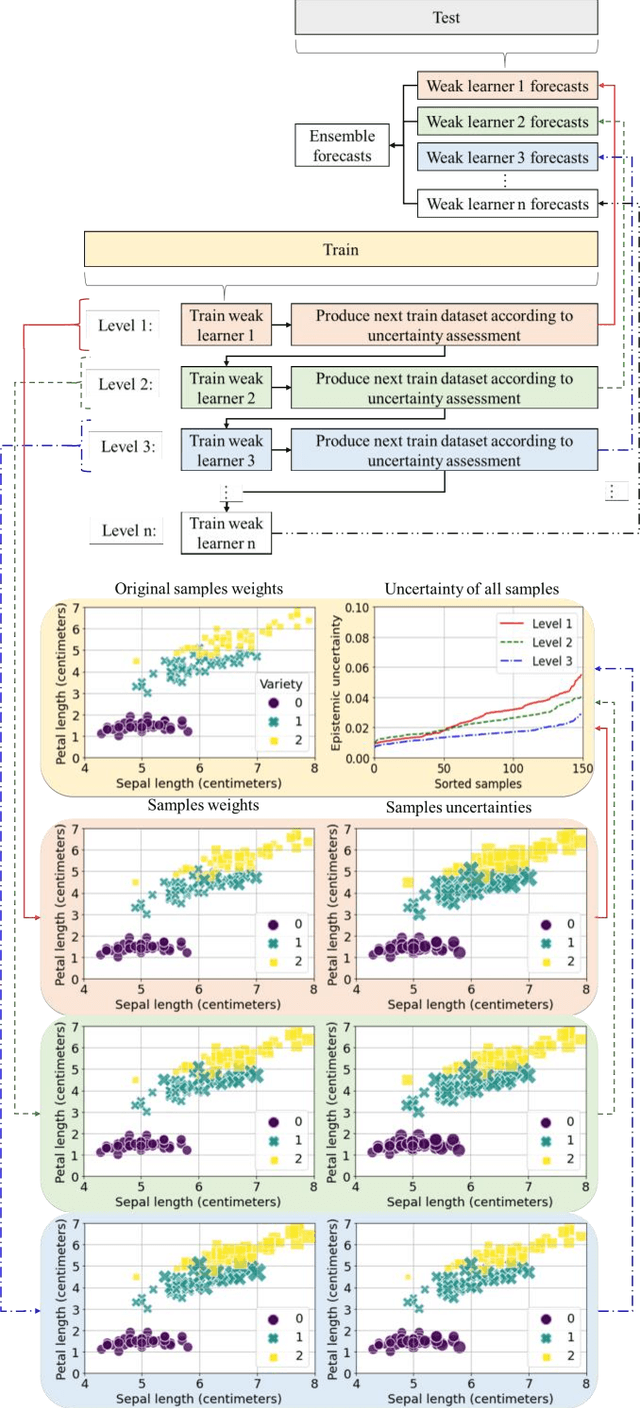
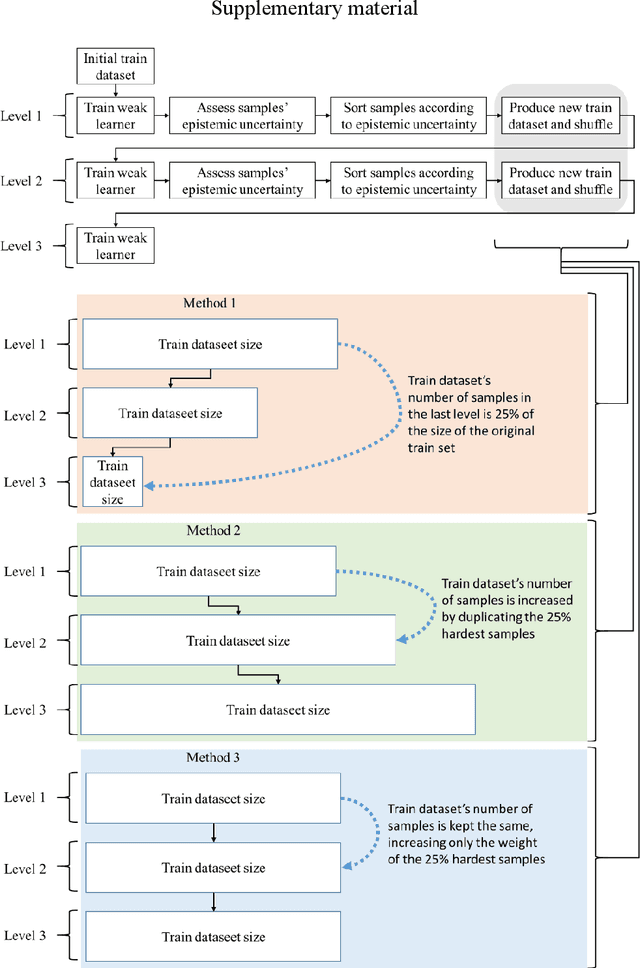
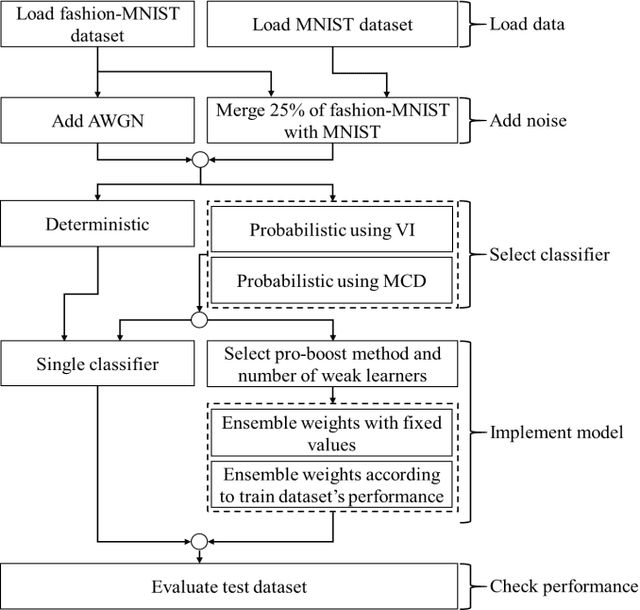
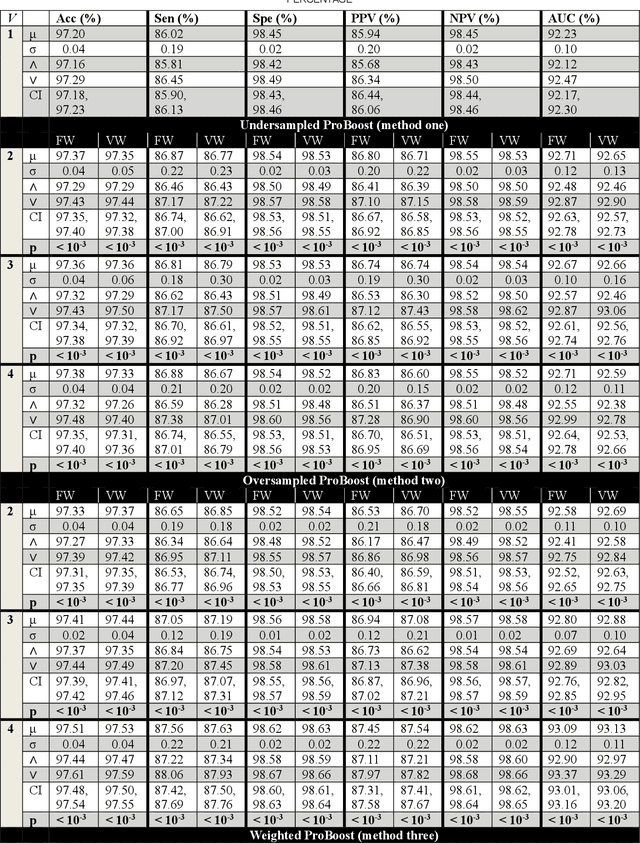
Abstract:ProBoost, a new boosting algorithm for probabilistic classifiers, is proposed in this work. This algorithm uses the epistemic uncertainty of each training sample to determine the most challenging/uncertain ones; the relevance of these samples is then increased for the next weak learner, producing a sequence that progressively focuses on the samples found to have the highest uncertainty. In the end, the weak learners' outputs are combined into a weighted ensemble of classifiers. Three methods are proposed to manipulate the training set: undersampling, oversampling, and weighting the training samples according to the uncertainty estimated by the weak learners. Furthermore, two approaches are studied regarding the ensemble combination. The weak learner herein considered is a standard convolutional neural network, and the probabilistic models underlying the uncertainty estimation use either variational inference or Monte Carlo dropout. The experimental evaluation carried out on MNIST benchmark datasets shows that ProBoost yields a significant performance improvement. The results are further highlighted by assessing the relative achievable improvement, a metric proposed in this work, which shows that a model with only four weak learners leads to an improvement exceeding 12% in this metric (for either accuracy, sensitivity, or specificity), in comparison to the model learned without ProBoost.
Understanding Unfairness in Fraud Detection through Model and Data Bias Interactions
Jul 13, 2022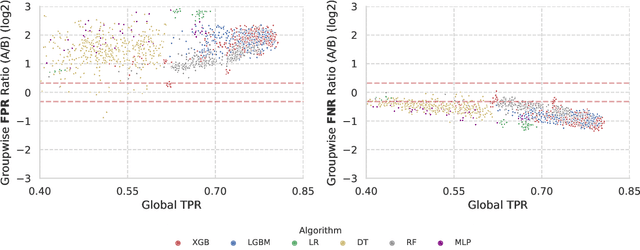

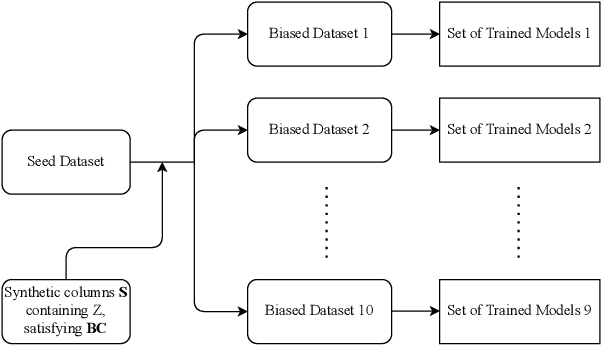

Abstract:In recent years, machine learning algorithms have become ubiquitous in a multitude of high-stakes decision-making applications. The unparalleled ability of machine learning algorithms to learn patterns from data also enables them to incorporate biases embedded within. A biased model can then make decisions that disproportionately harm certain groups in society -- limiting their access to financial services, for example. The awareness of this problem has given rise to the field of Fair ML, which focuses on studying, measuring, and mitigating unfairness in algorithmic prediction, with respect to a set of protected groups (e.g., race or gender). However, the underlying causes for algorithmic unfairness still remain elusive, with researchers divided between blaming either the ML algorithms or the data they are trained on. In this work, we maintain that algorithmic unfairness stems from interactions between models and biases in the data, rather than from isolated contributions of either of them. To this end, we propose a taxonomy to characterize data bias and we study a set of hypotheses regarding the fairness-accuracy trade-offs that fairness-blind ML algorithms exhibit under different data bias settings. On our real-world account-opening fraud use case, we find that each setting entails specific trade-offs, affecting fairness in expected value and variance -- the latter often going unnoticed. Moreover, we show how algorithms compare differently in terms of accuracy and fairness, depending on the biases affecting the data. Finally, we note that under specific data bias conditions, simple pre-processing interventions can successfully balance group-wise error rates, while the same techniques fail in more complex settings.
Human-AI Collaboration in Decision-Making: Beyond Learning to Defer
Jun 27, 2022Abstract:Human-AI collaboration (HAIC) in decision-making aims to create synergistic teaming between human decision-makers and AI systems. Learning to Defer (L2D) has been presented as a promising framework to determine who among humans and AI should take which decisions in order to optimize the performance and fairness of the combined system. Nevertheless, L2D entails several often unfeasible requirements, such as the availability of predictions from humans for every instance or ground-truth labels independent from said decision-makers. Furthermore, neither L2D nor alternative approaches tackle fundamental issues of deploying HAIC in real-world settings, such as capacity management or dealing with dynamic environments. In this paper, we aim to identify and review these and other limitations, pointing to where opportunities for future research in HAIC may lie.
 Add to Chrome
Add to Chrome Add to Firefox
Add to Firefox Add to Edge
Add to Edge